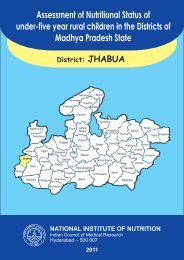Assessment of Nutritional Status of under-five year rural children in ...
Assessment of Nutritional Status of under-five year rural children in ...
Assessment of Nutritional Status of under-five year rural children in ...
Create successful ePaper yourself
Turn your PDF publications into a flip-book with our unique Google optimized e-Paper software.
complementary feed<strong>in</strong>g with spoon. The feed<strong>in</strong>g was supervised mostly by the mother(Table 12).4.6.2.2 12-35 month <strong>children</strong>About 69% <strong>of</strong> the <strong>children</strong> were currently receiv<strong>in</strong>g complementary foods <strong>in</strong> additionto breast milk, 31% <strong>of</strong> the <strong>children</strong> were not breast fed. The type <strong>of</strong> food be<strong>in</strong>g currentlygiven <strong>in</strong>cluded home made semi-solids (95.5%) and/or solids (89.7%) cow/buffalomilk (75.8%). The most commonly used food groups <strong>in</strong>cluded cereals & millets andpulses (97% each), GLV and other vegetables (93% each), fruits (92%), roots &tubers (87%), Milk & milk products (86%), fats & oils (79%), eggs (26%) and fleshfoods (17%). About 33% <strong>of</strong> the <strong>children</strong> were fed ≥ 4 times a day, 49% were fed 3times a day, while 18% were fed ≤ 2 times a day. About 40% <strong>of</strong> the <strong>children</strong>consumed food themselves mostly with hands. About 57% <strong>of</strong> <strong>children</strong> were fed bytheir mothers, either by hand (53%) or with spoon (4%). In most cases, feed<strong>in</strong>g wassupervised by their mothers (92%), followed by grand parents and elder sibl<strong>in</strong>gs (4%each) (Table 13).4.6.3 Care <strong>of</strong> the ChildAbout 70% <strong>of</strong> mothers reportedly were tak<strong>in</strong>g care <strong>of</strong> their <strong>children</strong> by themselves athome, while 10% stated that they were cared by the grand parents and 7% by the oldersibl<strong>in</strong>gs (Table 14). About 11% <strong>of</strong> the mothers carried their <strong>children</strong> to the work-spot.4.6.4 Personal HygieneOnly 16% <strong>of</strong> mothers washed their hands with soap before feed<strong>in</strong>g the child.About 31% <strong>of</strong> mothers were us<strong>in</strong>g soap for wash<strong>in</strong>g their hands after defecation(Table 14).4.6.5 History <strong>of</strong> MorbidityThe particulars <strong>of</strong> morbidity dur<strong>in</strong>g preced<strong>in</strong>g fortnight among
















